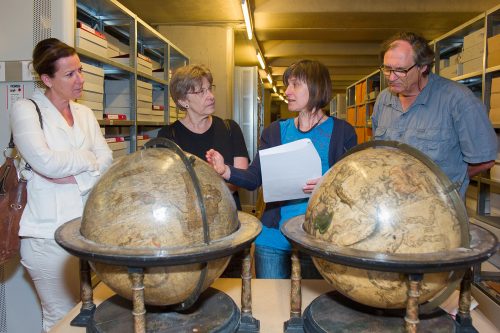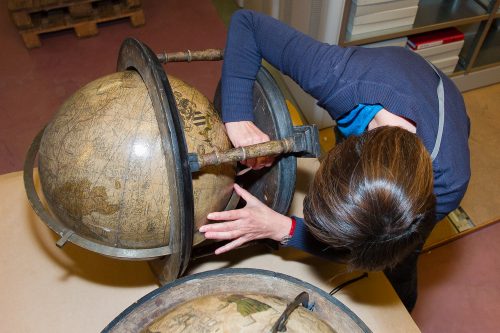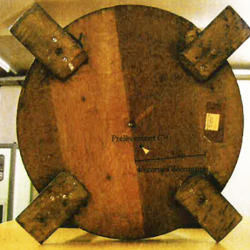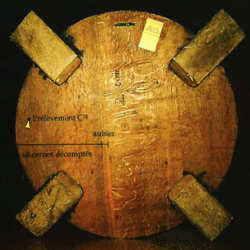Dating the stands
Dendrochronological certification was conducted as a prelude to C14 radiocarbon dating of fragments of wood taken from the stands of the terrestrial and celestial globes. This certification was meant to ensure that the samples were relevant for the analyses.
The samples were drawn in 2012 by Jean Tercier and Jean-Pierre Hurni of the West Swiss Laboratory of Dendrochronology in Moudon, who also directed the C14 dating performed by Dr Irka Hajdas at the ETH Laboratory for Ion Beam Physics, Radiocarbon Dating in Zurich.
About 45 growth rings were counted on this plank. There was no sapwood signalling the proximity of the bark. The fragment came from a ring close to the heart of the tree, at about 42 rings from the outermost one of the plank. These observations made it possible to further pinpoint the date the tree was cut down.
The oak tree was felled at least 67 years after the date of the growth ring given by radiocarbon testing (42 years since the growth ring that was analysed, plus at least 25 more rings for the missing sapwood).
| Dendrochronological dating yielded the following result : | ||
| Tree felled | 1527-1707 | probability 95.4% |
| C14 radiocarbon dating yielded the following result : | ||
| Wood from stand | 1460-1640 | probability 95.4% |
Sur cette planche, environ 60 cernes de croissance ont été décomptés, dont 6 cernes d’aubier. L’aubier présente une teinte plus claire que le bois de coeur. Il est situé à la périphérie du tronc, sa présence indiquant la proximité de l’écorce. Le fragment provient d’un cerne proche du coeur de l’arbre, à environ 55 cernes du cerne de croissance le plus extérieur de l’aubier. Ces observations permettent d’affiner les résultats pour approcher au plus près la date d’abattage de l’arbre.
L’abattage du chêne est d’environ 75 ans plus récent que la date du cerne analysé par le radiocarbone (55 années depuis le cerne analysé, auxquelles s’ajoutent 20 cernes d’aubier manquant).
| Dendrochronological dating yielded the following result : | ||
| Tree felled | 1485-1525 | probability 95,4% |
| C14 radiocarbon dating yielded the following result : | ||
| Wood from stand | 1410-1450 | probability 95,4%/small> |
Find out more
- Rapport d’analyse par le radiocarbone, Globe terrestre : Radiocarbon analysis report, terrestrial globe, West Swiss Laboratory of Dendrochronology, N° réf. LRD12/R6757R, 21.09.2012, Jean Tercier & Jean-Pierre Hurni, Moudon.
- Rapport d’analyse par le radiocarbone, Globe céleste : Radiocarbon analysis report, celestial globe, West Swiss Laboratory of Dendrochronology, N° réf. LRD12/R6756R, 21.09.2012, Jean Tercier & Jean-Pierre Hurni, Moudon.
- Stands : the globes sit on a circular base supported by four equidistant balusters, each with a rectangular foot.



